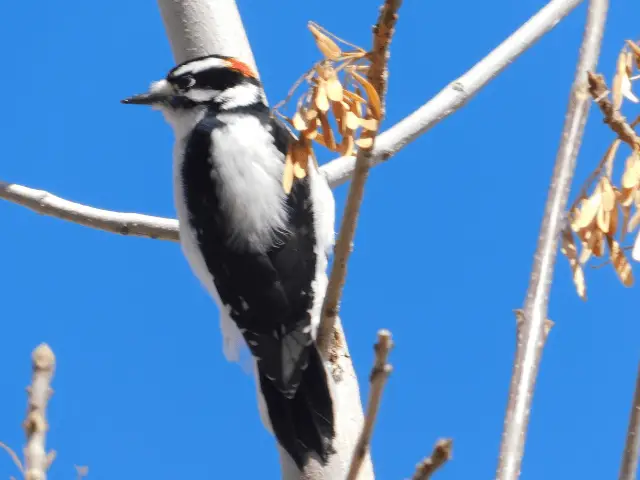The warm Georgian weather is highly welcoming for several backyard birds.
And...
The list also includes woodpeckers.
In total, there are eight indigenous Georgia woodpecker species that you can spot in the region if you plan things well and if you’re lucky.
Georgia once hosted the ivory-bellied woodpeckers, the largest North American species. Unfortunately, the species is not seen in the area anymore. However, this is not the same with other varieties of woodpeckers in Georgia.
Here, I’ll talk about widely available woodpeckers in GA that you might see on your visit.
Most Common All-Season Woodpeckers In Georgia
Some woodpecker species in Georgia are a common sight in winters but not in the hot season.
However, there are others you can enjoy seeing at any time of the year.
I have listed them as follows:
1. Red-Bellied Woodpecker
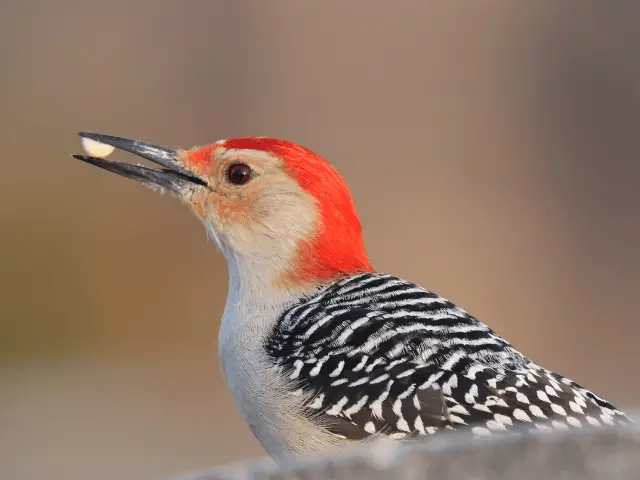
If you live in Georgia, you can enjoy seeing a red-bellied woodpecker all year around.
However, because of their red caps, they are often confused with red-headed woodpeckers. But a red-bellied woodpecker is much smaller in size as compared to the aforementioned. Here are some size specs for the red-bellied woodpecker to help you identify it correctly:
- Length: They are about 9.4 inches or 24 centimeters long.
- Weight: Their average weight lies between 2.0 and 3.2 oz. or 56-91 grams.
- Wingspan: The wing spin of a red-bellied woodpecker measures 13.0-16.5 inches or 33-42 cm.
The red-bellied woodpecker has a pale red-shaded belly which may be hard to spot at first glance. They also feature black and white marking on their back. A female red-bellied woodpecker will have a red nape, but it is not red on the crown.
If you are keen on seeing a red-bellied woodpecker, head to a bird feeder near you, especially if you live near the woods.
Feeding Information
Red-bellied woodpeckers love to feed on insects, spiders, seeds from grasses, nuts, and fruit seeds. At times they will also eat nestlings. As the red-bellied woodpecker usually nests in dead trees, they can easily find such food items naturally.
Spotting Locations
These types of woodpeckers are a common sight in forests and densely wooded areas in the eastern areas of the US. You can also see them on bird feeders in the area (if they have fresh food and water supply.)
Tips For Attracting Red-Bellied Woodpeckers (For Locals Only)
A red-bellied woodpecker will visit your backyard for suet. Try to install an upside-down suet feeder in your backyard; this way, you’ll also stop bully birds and squirrels coming to your feeder. Also, black oil sunflower seeds can attract red-bellied woodpeckers.
This way, you can have two feeders in one and better chances to see a red-bellied woodpecker in your garden. A hummingbird feeder is also a good option to meet and greet red-bellied woodpeckers in your yard.
Another way to attract them is to plant berry trees like mountain-ash and hawthorn near your place.
2. Red-Headed Woodpecker
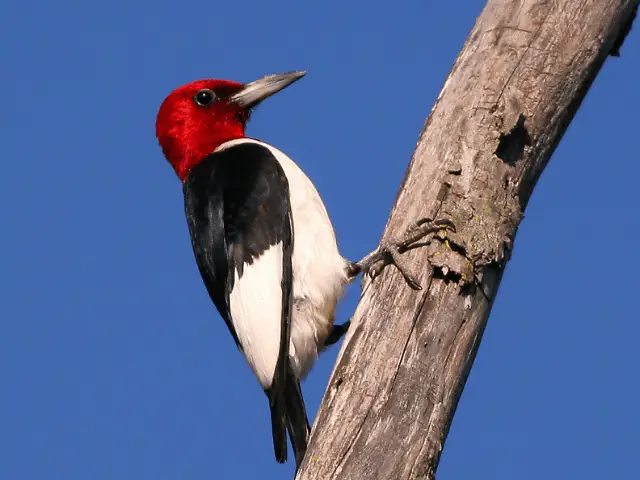
The red-headed woodpecker is another all-year Georgian species of woodpecker. You can easily identify them with their black and white bold markings and bright red-shaded heads. The red-headed woodpecker is medium in size and has a powerful spike bill.
They also feature black-shaded backs and white bands on the wings; this species has shorter tails. Some specifications have been listed as follows:
- Length: The red-headed woodpecker is about 7.5-9.1 inches or 19-23 cm long.
- Weight: They weigh around 2.0-3.2 oz. or 56-91 grams.
- Wingspan: The wingspan of red-headed woodpeckers is about 16.5 inches or 42 cm.
They can also catch insects in crevices and mid-flight like other woodpeckers.
Feeding Information
They like to feed on beetles, honeybees, midges, and grasshoppers, but this insect meal only makes only one-third of their diet. The other two-thirds are composed of nuts, seeds, and berries. They also take nestling or eggs from mice and other birds.
Spotting Locations
They can usually find them in the farms, woodlots, pine savannas, and dead timber in swamps.
Alternatively, you can also welcome them in the backyard using birdfeeders (if you’re a local); a suet bird feeder is an ideal way of attracting these birds to your yard.
Additional Information
However, recently there has been a huge decline of this species due to loss of feasible habitat.
3. Pileated Woodpecker
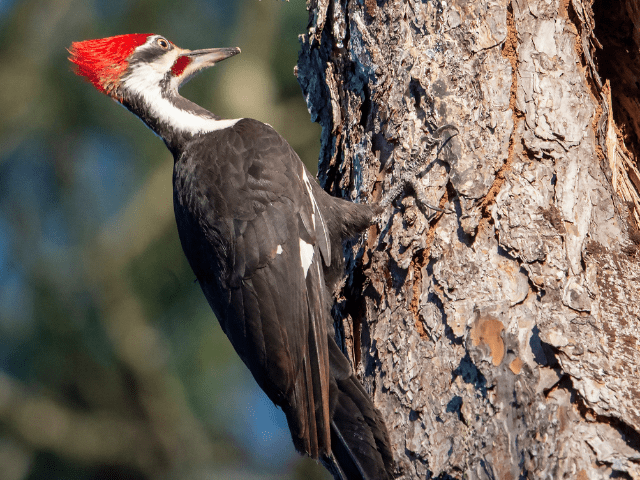
The pileated woodpecker is among the most commonly found types of woodpeckers in Georgia. You can easily see them all year round in the region and are very likely to come across them during your visit.
They have a striking appearance, thanks to the flaming red triangle crest, which means that you won’t have much trouble identifying them correctly.
Here are the specific measures:
- Length: The pileated woodpecker is about 15.8-19.3 inches or 40-49 cm in length.
- Weight: They weigh around 8.8-12.3 oz. or 250-350 grams.
- Wingspan: The wingspan of a pileated woodpecker is about 26.0-29.5 inches or 66-75 cm.
By far, the pileated woodpecker is the biggest of the species of Georgia woodpeckers and is almost the same size as that of a crow. They are mostly black with white stripes; the males have an additional red stripe on their cheeks.
Feeding Information
This species likes to eat carpenter ants, mostly from dead trees or fallen logs, but they have an appetite for termites, beetle larvae, and other insects as well.
They also like to eat nuts and fruits like sumac berries, dogwood, elderberry, and blackberries.
Spotting Locations
The pileated woodpecker can be seen in dense or drowned forests with dead trees.
If you wish to attract them to your yard, install a suet feeder; you can serve then black oil sunflower seeds, peanuts, mealworms, hulled sunflower seeds, or suet.
Acoustics
You can hear them making loud, whinny calls or drumming sounds.
4. Downy Woodpeckers
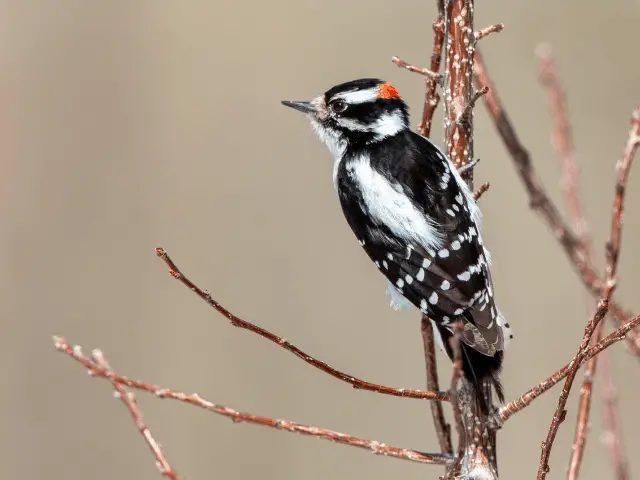
You can find these woodpeckers all year round in the region.
These are by far the smallest known species of Georgian woodpeckers and North America.
- Length: The downy woodpeckers are about 5.5-6.7 inches or 14-17 cm long.
- Weight: These woodpeckers weigh between 0.7 and 1.0 oz or 21 to 28 grams.
- Wingspan: They have a wingspan of 9.8 to 11.8 inches or 25 to 30 cm when fully grown.
Feeding Information
These woodpeckers usually feed on insects and love to eat larvae; they also like to eat nuts, berries, grains, and acorns.
You can also see them feeding and drinking on hummingbird feeders.
Appearance
The downy woodpeckers are much similar to hairy in their looks to woodpeckers.
They generally have white and black patterns on the back. Occasionally, the males might have a red patch on the back of their heads.
Spotting Locations
You can easily spot a downy woodpecker in the backyard or on a hummingbird feeder. These woodpeckers make high-pitched sounds or descending whinny calls. These woodpeckers are very active. Hence, it is fun to watch them in your garden.
These birds also like to nest in the cavities of dead trees.
You can find them in the parks or orchards where there is fresh food and water supply.
5. Yellow-Bellied Sapsucker
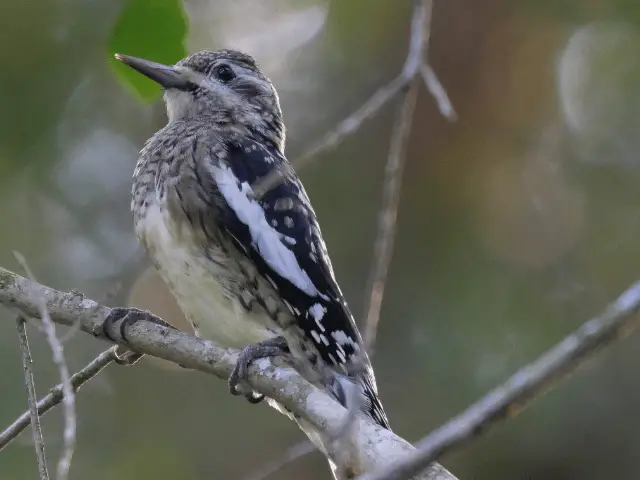
The yellow-bellied sapsucker is another famous type of woodpecker you can find in Georgia. These are migratory and can be seen in the winters. They visit Georgia after breeding in Canada and the Northern American States. In size, they are comparable to robins.
- Length: The yellow-bellied sapsuckers are about 7.1 to 8.7 inches long.
- Weight: A grownup yellow-bellied sapsucker weighs 1.5-1.9 oz or 43-55 grams.
- Wingspan: An adult yellow-bellied sapsucker has a wingspan of 13.4 to15.8 inches or about 34 to 40 cm.
Appearance
The yellow-bellied sapsuckers are mainly black on the back and have red foreheads. The males have a distinct red throat as well.
Spotting Locations
You can easily spot a yellow-bellied sapsucker in dark forests or on the maple or birch trees.
This is where they usually make sap-well rows to feed on.
Additional Information
These woodpeckers make holes in the tree trunks and use their tongue to get the saps out.
They create neat horizontal holes in a row. So if you see rows of holes in yellow birch, paper birch, sugar/red maple, and hickory trees, expect to see yellow-bellied woodpeckers in there. They also take care of the holes to allow easy flow of sap.
On average they lay 5 to 6 white eggs at a time.
Frequently Asked Questions
What kind of woodpeckers are in Georgia?
There are mainly 8 habitant woodpeckers of Georgia. If you wish to find the real difference, look at the pictures of woodpeckers in Georgia. Only by deeply examining their pictures, can you see the differences in the sizes, colors, and other features.
Some of the common Georgia woodpeckers species you can hope to see are:
- Red-bellied Woodpecker
- Red-headed Woodpecker
- Hairy Woodpecker
- Downy Woodpecker
- Pileated Woodpecker
- Northern Flicker
- Red-cockaded Woodpecker
- Yellow-bellied Sapsucker
Going into the thick woods or dark forests will be your best bet for spotting these colorful birds. However, with the right type of bird feeder for woodpeckers, you can also welcome them to your yard and enjoy the sight without leaving the comfort of your place.
Are woodpeckers protected in Georgia?
Yes, they are protected in Georgia under the law. The migratory bird act demands special permission from the Federal Government before controlling any woodpeckers in the state. These permits might not be issued to all parties. Moreover, Urban Wildlife Control implements a set of non-lethal methods for removing woodpeckers from any given area.
Is it illegal to shoot a woodpecker in Georgia?
Yes, the woodpeckers of Georgia are protected under the Migratory Bird Treaty Act. Under the law, you cannot kill or capture these birds without a permit. Therefore, if you want to avoid woodpecker damage in your surroundings, look for other legal methods to frighten the birds.
It is important to read the legal procedures or look for a permit and avoid any ideas of your own.
Before you move to the end, check out this amazing pileated woodpecker drumming on a tree:
Final Words
Woodpeckers are exotic birds for many, they are rare in several parts of the world. However, Georgia’s unique conditions and surroundings allow you to enjoy the sight of these heavenly birds in several spots throughout the region.
You can visit the nearest woods to experience them in their natural climate or go for a suitable bird feeder in your backyard. With appropriate measures, food, and a place to live, you can welcome them to visit you any time of the year.
Indeed, spending your leisure time with these little colorful birds is sure to lift your spirits.

